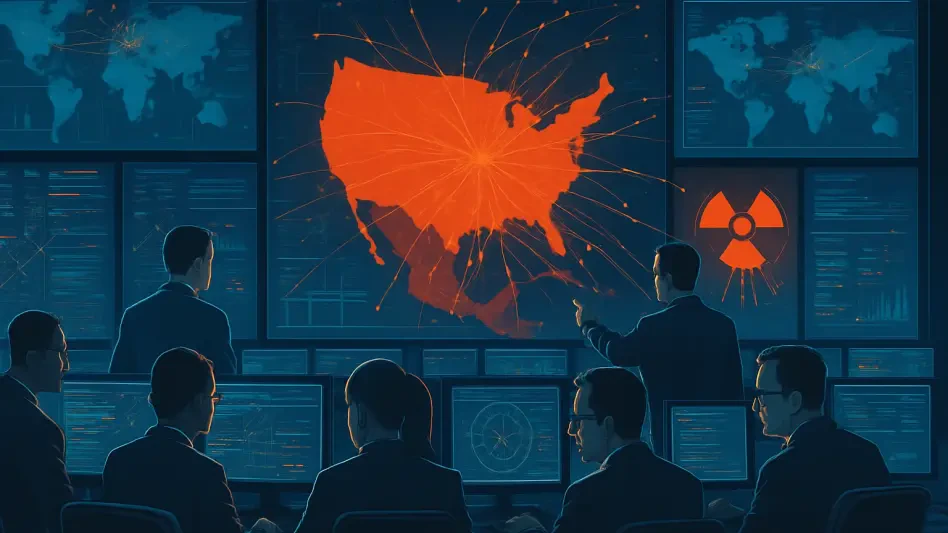In a world increasingly reliant on electricity, what happens when the power grid—the backbone of modern life—becomes a prime target for cyberattacks and physical sabotage, leaving hospitals in darkness, businesses at a standstill, and entire communities cut off from essential services due to a single, coordinated strike on critical infrastructure? This chilling reality is no longer a distant fear but a pressing concern as threats to the North American electric grid grow more sophisticated by the day. Enter GridEx VIII, a biennial exercise that in 2023 rallied over 370 organizations to test and strengthen the resilience of this vital system. This initiative, far from a mere simulation, stands as a crucial defense mechanism in an era of escalating danger.
The significance of this exercise cannot be overstated. With a nearly 50% increase in participation compared to previous years, GridEx VIII reflects an industry-wide acknowledgment of the urgent need to safeguard the grid. Organized by the North American Electric Reliability Corporation’s Electricity Information Sharing and Analysis Center (E-ISAC), it serves as a proving ground for utilities and stakeholders to confront both digital and physical threats head-on. Beyond just preparation, the event fosters collaboration and innovation, ensuring that the grid remains a lifeline rather than a liability in times of crisis. As risks evolve, so too must the strategies to counter them, making this exercise a cornerstone of national security and public safety.
Why Grid Security Demands Attention Now
The stakes for grid security have never been higher. Cyberattacks, such as ransomware that can paralyze utility operations in hours, are becoming alarmingly frequent, with the FBI reporting a 37% rise in such incidents targeting critical infrastructure since 2021. Physical attacks on substations, meanwhile, have disrupted power to thousands in recent documented cases across North America. These dual threats underscore a harsh truth: the grid is a target, and its failure would ripple through every facet of society, from healthcare to commerce.
This vulnerability has galvanized the utility sector into action. The sharp uptick in threats has pushed grid security from a niche concern to a top priority, prompting unprecedented engagement in exercises like GridEx VIII. The initiative provides a rare opportunity to simulate worst-case scenarios in a controlled environment, revealing weaknesses before real adversaries exploit them. It’s a race against time, as the complexity of attacks continues to outpace traditional defenses, demanding constant vigilance and adaptation.
The Rising Tide of Threats to Grid Resilience
Beyond the immediate dangers, the broader landscape reveals an even grimmer picture. Sophisticated malware can infiltrate systems undetected for months, while coordinated physical assaults on infrastructure aim to maximize disruption. A notable 2023 incident saw multiple substations in the Pacific Northwest targeted simultaneously, leaving over 40,000 customers without power for days. Such events highlight how interconnected and fragile the grid truly is when faced with determined adversaries.
GridEx VIII emerged as a direct response to this intensifying hostility. With participation soaring to over 370 organizations in 2023, the exercise reflects a collective alarm over the grid’s susceptibility. Hosted by the E-ISAC, it unites utilities, government agencies, and private entities to confront these challenges together. This growing coalition signals a shared understanding that no single organization can stand alone against threats of this magnitude—collaboration is no longer optional but essential.
Unpacking GridEx VIII: Design and Diverse Involvement
At its core, GridEx VIII is a meticulously structured event tailored to address a spectrum of risks. Participants can choose from three distinct formats: the immersive Standard Scenario for full-scale crisis simulations, the compact GridEx-in-a-Box for smaller or resource-limited teams, and the discussion-driven Tabletop Scenario for those prioritizing strategic dialogue over operational drills. This flexibility ensures that entities of all sizes, from rural cooperatives to major urban utilities, can engage meaningfully.
The exercise zeros in on both cyber and physical threats, testing everything from initial response to prolonged recovery. A standout addition in 2023 was the dedicated recovery phase, known as Move 4, which focuses on restoring services after a catastrophic event. By simulating real-world challenges like malware breaches or infrastructure damage, the program equips participants with practical insights into managing chaos under pressure. This adaptability makes it a vital tool for building resilience across diverse operational contexts.
Such a design also fosters inclusivity in preparedness efforts. Whether a small utility grappling with budget constraints or a large corporation with complex systems, each organization finds a pathway to strengthen its defenses. The tailored scenarios ensure that specific regional risks—be it a cyber intrusion in a tech-heavy area or physical sabotage in a remote location—are addressed with precision, enhancing the grid’s overall stability.
On the Front Lines: Participant Perspectives
Hearing directly from those involved in GridEx VIII reveals its profound impact. A senior manager from a Midwest utility shared, “This exercise forced us to confront gaps in our emergency protocols we didn’t even know existed—it’s a wake-up call.” Such candid reflections highlight how the simulations go beyond routine training, pushing organizations to rethink their approach to crisis management in tangible ways.
The E-ISAC’s support mechanisms, including webinars like “GridEx Last Steps and Q&A,” have also earned high praise. A planner from a smaller cooperative noted, “Customizing scenarios with the provided tools helped us pinpoint flaws in our cyber defense strategy—something we couldn’t have done alone.” With over 370 entities involved, the sheer scale of engagement underscores the trust placed in this initiative. These voices, combined with data showing a spike in threat sophistication, illustrate an industry united in its determination to outmaneuver potential disruptors through shared experience and rigorous practice.
Fortifying the Future: Lessons and Tools from the Exercise
GridEx VIII offers more than just a testing ground—it delivers actionable strategies for lasting security. Utilities are encouraged to use resources like the Master Scenario Events List (MSEL) to craft simulations specific to their vulnerabilities, whether that’s a cyber breach or a targeted attack on a key facility. This customization ensures that preparation aligns directly with real-world risks faced by each participant.
Collaboration is another critical takeaway. The E-ISAC’s Planner Directory connects organizations with regional partners, allowing smaller utilities to learn from more experienced counterparts during drills. Training materials and recorded sessions available on the Planner Resources Site further empower teams to enhance skills and meet regulatory standards. By addressing both immediate crisis response and long-term recovery—through innovations like tabletop-specific recovery scenarios—the exercise provides a comprehensive blueprint for resilience.
Perhaps most crucially, it instills a mindset of continuous improvement. Participants leave not just with data from simulations but with a renewed focus on integrating lessons into daily operations. From upskilling staff to refining inter-agency communication, the strategies gleaned from this event lay the groundwork for a stronger, more adaptive grid capable of withstanding tomorrow’s threats.
Reflecting on a Milestone in Grid Defense
Looking back, GridEx VIII proved to be a defining moment in the fight to protect the North American electric grid. With over 370 organizations joining forces in 2023, the event showcased an unprecedented commitment to confronting cyber and physical dangers through simulation and partnership. It bridged gaps between large and small entities, ensuring that every corner of the industry had a stake in safeguarding critical infrastructure.
Moving forward, the lessons from this exercise must translate into sustained action. Utilities and stakeholders should prioritize regular drills, invest in staff training, and deepen regional collaborations to maintain momentum. Policymakers, too, can play a role by supporting initiatives that enhance grid security funding and innovation. As threats continue to evolve, staying ahead will require not just reaction but anticipation—building on the foundation laid by this pivotal effort to create a grid that endures against all odds.








